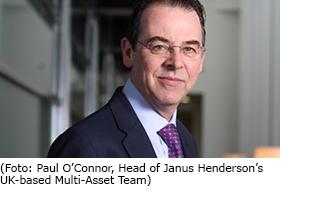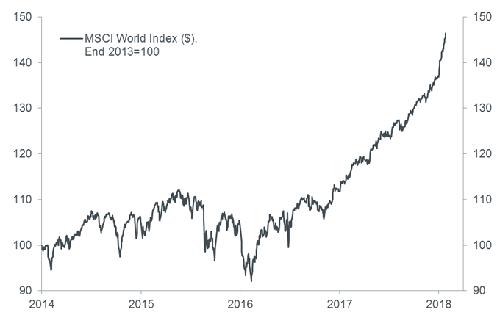
Janus Henderson: Multi-Asset view - Fade the surge
Paul O’Connor, Head of Janus Henderson’s UK-based Multi-Asset Team, warns the continuing rally in global equities could be symptomatic of investors chasing momentum. He explains why tactical manoeuvring could displace ‘buy and hold’ investment strategies.
31.01.2018 | 10:17 Uhr
 60% rally
60% rally
It might seem like a distant memory now, but it is only two years since global financial markets were gripped by panic, with investors scrambling to dump risk assets as China-centric concerns morphed into a full-on global growth scare. In that early 2016 sell-off, global equities concluded an 18% drop from the previous year’s highs, Brent crude oil completed an 18-month decline of 75% and US high yield bond yields spiked to 10%. How things change! Two years on, and global equities have rallied nearly 60% (chart 1), the oil price has more than doubled and most measures of financial market volatility are close to record lows.
Sentiment surge
We maintained a constructive view on risk assets throughout the 2017 rally, based on the view that the price action unfolding in most markets was a rational repricing of the improving global growth outlook. We still remain positive on the macro fundamentals, but the surge in equities over the last few weeks in January 2018 leaves us questioning just how much good news has now been priced into the asset class. Market psychology appears to have changed dramatically in just a couple of months, with investor sentiment seemingly becoming less driven by market fundamentals and more about momentum investing and performance chasing.
Chart 1: Global equities – the ascent of the MSCI World Index

Investors are all in
Besides the accelerating price moves seen in a number of markets in recent weeks, we see plenty of other evidence of a sizeable recent shift in investor attitude and behaviour:
- Individual investors in January were more bullish about the stock market outlook than at any time since data was first gathered in 2002 (University of Michigan Consumer Survey).
- Investment advisers in January were the most bullish they have been since 1986 (US Investor Intelligence Survey).
- The number of institutional investors reporting that they had taken protection against a market fall, dropped sharply in January to its lowest level since 2013 (Bank of America Global Fund Manager Survey).
- Net hedge fund equity exposure in January jumped to its highest level since 2006 (Bank of America Global Fund Manager Survey).
- Investor flows into equity funds in January have hit new all-time records.
It is notable that most such indicators have swung all the way from bearish extremes in early 2016, when the current rally began, to bullish extremes today. Even when we compare today's market to that of a few months ago, we see a big character change. Whereas the market environment for most of 2017 was shaped by investors gradually acknowledging improving macro fundamentals, this market looks more like a ‘momentum chase’, with everybody bullish and scrambling to get a piece of the action. That is not a healthy shift.
Warning signs
So, how should we respond to this change in the market environment? In our asset allocation work, we typically use measures of investor sentiment and positioning as contrarian indicators. We are inclined to add risk when the consensus is bearish and reduce risk when the crowd is exuberant. However, one key refinement of this approach is that the signals from these sorts of indicators work best when they are pointing in the direction of the prevailing trend. That is, in equity bull markets, sentiment and positioning models tend to be better at advising us on when to buy dips than when to sell rallies. This is because markets often overshoot.
A tactical retreat
Given these considerations, we are inclined to interpret the gathering evidence of the shift in investor sentiment and positioning as a warning sign for risk assets, rather than a clear sell signal. With macro fundamentals remaining fairly constructive, we are certainly not making the case for a reversal in the underlying uptrend in risk assets. However, we do believe that the recent surge has exhausted much of the potential for near-term capital gains and has increased the risk of a market pullback. Accordingly, we are tactically reducing our exposure to risk assets, buying some out-of-favour US Treasury bonds and adding to cash.
This is a tactical retreat to protect returns, not a change in our positive strategic stance on risk assets. Our desire to reduce risk now reflects a view that it is unwise to extrapolate market moves, once investor sentiment and positioning have reached extremes. Instead, we think it makes sense to prepare for a pick-up in volatility and more rotation within markets. More broadly, it seems increasingly plausible to us that the past two-year period which greatly rewarded buy-and-hold investors might be coming to an end, ushering in an era where greater tactical manoeuvring will be required from asset allocators and fund managers alike.



Diesen Beitrag teilen: